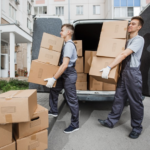Moving to a new house can be both exciting and stressful. The thought of starting fresh in a new place is invigorating, but the process of packing up and relocating can be overwhelming. With so many tasks to complete and things to remember, it’s easy to forget important details along the way.
To help you stay organized and ensure a smooth transition, we have created a moving house checklist. This comprehensive guide will walk you through all the necessary steps to prepare, pack, and move your belongings to your new home. We have included tips and tricks to make the process easier and more efficient.
Moving House Checklist
Here are the essential tasks you need to complete when moving house:
Create a Timeline:
One of the first things you should do when planning a move is to create a timeline. This will help you stay organized and on track with all the tasks that need to be completed before moving day.
Start by determining your moving date and count backward from there. Consider how much time you have to pack, what needs to be done before packing (i.e., decluttering, hiring movers), and when you need to inform utility companies and change your address with important institutions.
Declutter and Donate:
Moving is an excellent opportunity to declutter your belongings and get rid of things you no longer need or use. Before packing, go through each room and separate items into three categories: keep, donate/sell, and throw away.
Not only will this help reduce the number of items you’ll need to pack, but it will also save you money on moving costs. You can also donate or sell items that are in good condition, making someone else happy while earning a little extra cash.
Notify Utilities and Important Institutions:
One of the most crucial tasks when moving house is notifying utilities and important institutions about your change of address. This includes electricity, gas, water, internet/cable, phone services, banks, insurance companies, and any other subscriptions or memberships you may have.
Make a list of all the organizations you need to inform and their contact information. It’s recommended to do this at least two weeks before your moving date to ensure a smooth transition.
Pack Strategically:
Packing is a big part of moving, and it can often be the most challenging and time-consuming task. To make it more manageable, you need to pack strategically.
Start by packing non-essential items first, such as out-of-season clothes, holiday decorations, or extra kitchen appliances. These items won’t be missed if they’re packed away early.
Label Boxes:
Labeling boxes is essential to ensure your belongings end up in the right rooms and can be unpacked efficiently. Use a permanent marker to write the contents of each box, as well as which room it belongs in.
You can also color code boxes based on their respective rooms or priority levels. For example, you could use red labels for items that need to be unpacked first, blue labels for items that can wait, and green labels for items to be donated/sold.
Pack an Essentials Box:
Moving day can be chaotic, so make sure to pack an essentials box with all the necessary items you’ll need during the transition. This may include toiletries, a change of clothes, important documents (i.e., passports, lease agreements), and any medications.
Having a designated essentials box will save you from rummaging through multiple boxes to find what you need and ensure a smoother first day in your new home.
Hire Professional Movers:
If you have a large number of items or heavy furniture, it’s highly recommended to hire professional movers. They have the experience, equipment, and manpower to move your belongings quickly and safely.
Be sure to research and compare different moving companies to find the best fit for your budget and needs. It’s also a good idea to book movers at least a month in advance, especially during peak moving season.
Clean Before Moving In:
Before unpacking and settling into your new home, it’s essential to give it a thorough clean. This will ensure a fresh start and make it easier to set up your belongings.
You can either clean yourself or hire professional cleaners, but be sure to do it before moving day. This way, you won’t have to worry about cleaning while trying to unpack and organize your new space.
Familiarize Yourself with the New Area:
Moving to a new area means getting familiar with a new neighborhood. Take some time to explore your new surroundings, locate nearby amenities, gas and electricity meters and find out about local regulations and services.
You can also connect with your new neighbors, join community groups or social media pages, and get involved in events or activities to help you feel more at home in your new area.
Tips for a Successful Move:
Here are a few tips to help make your move even smoother:
Start packing early:
Packing takes a lot of time and effort, so it’s crucial to start early. Begin packing non-essential items at least a month before your moving date. This will give you plenty of time to sort through your belongings, declutter, and pack in an organized manner.
Starting early also means you won’t have to rush or make last-minute decisions about what to pack and what to leave behind. This can help reduce stress and make the move less overwhelming.
Use Quality Packing Materials:
Investing in quality packing materials may seem like an added expense, but it will save you from potential damage to your belongings during the move. Use sturdy boxes, bubble wrap, packing paper, and strong tape to secure your items.
You can also use household items like towels, linens, and clothing to wrap fragile items and save on packing materials. However, make sure they are clean and won’t cause damage to your belongings.
Take Photos Before Packing Electronics:
Taking photos of your electronics before packing them is a helpful tip that many people overlook. It may seem like an unnecessary step, but it can save you time and frustration when setting up your electronics in your new home.
Before unplugging any cords or disconnecting wires, take a photo of how everything is connected. This will serve as a reference when setting up your devices in your new home.
Plan for Pets:
If you have pets, it’s essential to plan for their relocation as well. Make arrangements for your pets to stay with a friend or family member during the move, or consider hiring a pet sitter.
If you’re moving long-distance, ensure that your pet has all necessary vaccinations and paperwork, and research pet-friendly accommodations along your route.
Have a Plan for Unpacking:
Just as you had a plan for packing, it’s crucial to have a plan for unpacking. Decide which rooms you want to set up first and prioritize unpacking those boxes.
You can also make an inventory list of your belongings and check them off as you unpack. This will help ensure that nothing gets left behind or misplaced during the move.
Don’t Forget to Update Your Address:
One important task that often gets overlooked during a move is updating your address. It’s crucial to notify the necessary parties of your new address to ensure a smooth transition and avoid missing important mail or packages.
Common mistake to avoid when moving:
Here are some common mistakes that people make when moving and how to avoid them.
Not purging before packing:
One of the biggest mistakes people make when moving is not decluttering or purging their belongings before packing. This can lead to unnecessary time, effort, and money spent on packing and transporting items that you don’t need or want in your new home.
To avoid this, take the time to go through your belongings and get rid of anything you no longer use or need. This can also help lighten your load and potentially save money on moving costs.
Not labeling boxes:
Another common mistake is not labeling boxes properly. Without labels, it can be challenging to find specific items when unpacking, leading to added stress and frustration.
To avoid this, be sure to label each box with the room it belongs in and a brief description of its contents. This will make unpacking much more manageable and organized.
Not booking movers in advance:
As mentioned earlier, it’s crucial to book professional movers well in advance, especially during peak moving season. Many people make the mistake of waiting until the last minute, only to find that all the reputable moving companies are fully booked.
To avoid this, start researching and booking movers at least a month in advance. This will give you time to compare prices and services and secure a moving company that fits your needs.
Not taking proper care of fragile items:
Fragile items require extra care when packing and transporting. Many people make the mistake of not properly securing fragile items, leading to damage during the move.
To avoid this, use quality packing materials and take the time to wrap each fragile item individually. You can also label these boxes as “fragile” to ensure they are handled with care.
Not having a backup plan:
Despite all the planning and preparation, sometimes things don’t go as planned. That’s why it’s essential to have a backup plan in case of any unexpected issues or delays.
This could mean having an alternative route planned, extra packing materials on hand, or arranging for temporary accommodation in case your move is delayed. Having a backup plan can help alleviate stress and ensure a smoother move overall.
FAQs
Why is a comprehensive moving house checklist important?
Understand the significance of a comprehensive moving house checklist and learn about specific items that should be included. Explore the importance of final meter readings and the steps involved in updating utility providers and insurance companies when transitioning to a new property.
How can a moving house checklist help coordinate with a removals company?
Explore how a moving house checklist can facilitate coordination with a removals company, contributing to a seamless transition. Learn about considerations for the storage unit and the management of electricity meters, ensuring a well-organized and stress-free moving process.
What role does the comprehensive moving house checklist play in managing all your important documents?
Understand the role of a comprehensive moving house checklist in managing all important documents. Explore how the checklist guides individuals in handling final meter readings and notifying the post office when moving to a new property, ensuring a thorough and organized approach to the moving process.
Conclusion:
Moving can be a daunting and overwhelming process, but with the right tips and preparation, it can also be an exciting new chapter in your life. Remember to start packing early, use quality packing materials, take photos of electronics before unplugging them, plan for your pets, and have a plan for unpacking.
Avoid common mistakes such as not purging before packing, not labeling boxes, not booking movers in advance, not taking care of fragile items, and not having a backup plan. With these tips in mind, your move will be less stressful and more organized.






